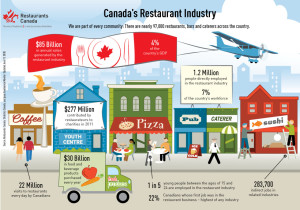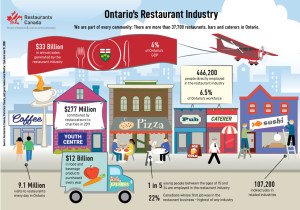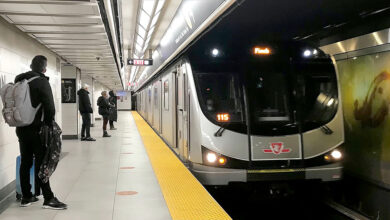Geração Z está a mudar a indústria da restauração
A geração Z (pessoas nascidas entre 1990 e 2010) representa cerca de 25% da população atual – é mais do que Millennials e Boomers juntos. E em pouco tempo o número aumentará para 33%, de acordo com os dados das Nações Unidas. Para estes jovens canadianos, encomendar hoje comida tailandesa ou sushi tornou-se tão banal como era encomendar pizza nas gerações anteriores.

Esta geração é a primeira da história que nasceu na era digital, quer isto dizer que estão sempre conectados online e que essa realidade mudou para sempre a forma como se relacionam com o mundo, inclusive com a comida.
Em 2018 os canadianos encomendaram refeições no valor de $4.3 mil milhões, cerca de mil milhões de dólares foram encomendados através de apps como a Uber Eats, Foodora, SkipTheDishes, DoorDash ou Just Eat. Os números são do Ipsos Foodservice Monitor e tudo leva a crer que tenham aumentado em 2019.
No universo das apps para encomendar comida, uma nasceu no Canadá: falamos da SkipTheDishes que foi fundada em 2012 em Winnipeg, na província de Manitoba. A startup cresceu e nos últimos anos a empresa, fundada por dois irmãos, expandiu-se para outras cidades canadianas e para os EUA. Em 2016 foi comprada por $200,000,000 pela britânica Just Eat.
Em cada uma das vendas, a app cobra uma comissão que varia entre os 20% e os 30%, algo que está a deixar os empresários da restauração preocupados. Segundo a Restaurants Canada, a indústria da restauração representa $85 mil milhões, qualquer coisa como 4% do PIB canadiano. No país existem cerca de 97,000 restaurantes, bares e fornecedores. Na província de Ontário a indústria gera $33 mil milhões, o que corresponde a 4% do PIB de Ontário.
Em Toronto já existem vários restaurantes especializados apenas em encomendas e onde não é possível entrar e pedir uma mesa. O BlogTo fez a lista e nenhum deles é português: LafLaf, Divine Dumplings, Kitchen Hub, Jackpot Brandz e 6ix Food Hall. Todos trabalham com várias apps e o último está “aberto” 24 horas por dia e sete dias por semana. Mas no universo das apps deste ramo encontramos ainda a Platterz, que é especialista em catering para escritórios, a Boozer que entrega em casa bebidas alcoólicas ou até a Chanmao que é especialista na entrega de comida chinesa.
Abaixo publicamos uma entrevista com a Restaurants Canada, a associação nacional que representa o setor. Roberto Sarjoo é Diretor de Marketing e de Comunicação da Restaurants Canada.

Milénio Stadium: Foodservice businesses have changed a lot since the beginning of this Association that was created in 1944. Now we have new players on the market and some entrepreneurs say that food apps have very high commissions. What are the real consequences of this changes to this industry that contributes with 4% to national GDP?
Roberto Sarjoo, Restaurants Canada: Indeed, the Canadian foodservice industry is growing. Since 1990, Canada’s foodservice industry has more the tripled in size and is projected to grow to a record $97 billion in annual sales in 2020. In addition, the foodservice industry posted the fastest economic growth of any major industry in Canada over the past decade.
While we’ve experienced robust foodservice sales growth in recent years, consumers are also demanding convenience. This has led to the rise of third-party delivery services. Total delivery sales (traditional and non-traditional) accounted for 6.4% of total Canadian restaurant sales in 2019, compared to 4.5% in 2015. Digital delivery sales have increased by an average of 45% per year for the past two years. While this has been positive in generating topline sales, for many operators, the commission fees are too high.
A Restaurants Canada survey of foodservice operators found that 74% of respondents rate third-party delivery services as “poor” or “very poor” in terms of the reasonableness of their commission fees. As a result, 55% of respondents said that using third-party apps/websites for delivery/take out is just “slightly profitable”. Another 21% said it was “not at all profitable”.
A further issue is that third-party delivery can convert a profitable, frequent on-premise guest into a less profitable delivery guest. This is especially true for full-service restaurants where 53% of respondents said third-party delivery services were “poor” or “very poor” at converting third-party delivery interactions into in-restaurant visits.
So while the overall industry is growing, this is putting pressure on foodservice operators. The combination of high commission fees, along with rising labour costs, food costs, rent and utilities led to a worsening financial performance in 2019 for nearly half of foodservice operators. In an industry with razor-thin profit margins of just 4.2%, eroding profit margins make it a challenge for operators to expand and grow their business, as well as expand their workforce. This will have significant implications for Canada’s economy, especially anyone looking for first-time job experience.
MS: What is the role of Restaurants Canada in the market?
R.Sarjoo, R.Canada: Restaurants Canada is a national, not-for-profit association representing Canada’s diverse and dynamic foodservice industry. Founded in 1944, Restaurants Canada is the largest membership organization of its kind, and the only national association that serves the unique needs of the foodservice industry. For 75 years, we have been providing invaluable research and insights, advocacy on key issues impacting foodservice businesses, updates on industry news, networking and trade events like the RC Show to bring the industry to connect to learn, connect and grow, and cost-saving programs to keep foodservice businesses competitive.
MS: How many restaurants do operate with food apps in Canada/Ontario?
R.Sarjoo, R.Canada: We only have overall data for Canada. 62% of quick-service restaurants responding to our Restaurant Outlook Survey said they offer delivery via a third-party app/website (such as Uber Eats, Skip the Dishes). By comparison, only 34% of table-service restaurants said they offer delivery through a third-party app/website.
MS: In Toronto some restaurants only do food delivery. Do they operate with the same rules?
R.Sarjoo, R.Canada: We know from a recent survey of Canadian foodservice operators that 9% of quick-service restaurants with a storefront also have a ghost kitchen compared to just 2% of table-service restaurants that also operate a ghost kitchen. However, over the next two years, 16% of quick-service restaurants and 18% of table-service restaurants are planning to offer delivery through ghost kitchens. Foodservice businesses that only offer delivery must adhere to the same food safety and health regulations as any other foodservice business. They are also subject to all other rules of a registered business.
MS.: Traditional restaurants with tables and chair will disappear?
R.Sarjoo, R.Canada: Traditional dining out at a restaurant as we know it is not expected to fade away. In total, 87% of restaurant operators believe to some degree that Canadians will continue to place importance on social dining experiences at restaurants over the next five years. In fact, for as much as you hear about convenience, tiny urban kitchens, and a lack of time driving patrons to restaurants, the most recent Statistics Canada data reveals that 52% of Canadians dine out as a treat, to celebrate, and to socialize.
While the look and feel of restaurants have changed and continue to do so, there’s still a need for a place for people to gather and connect face to face, and there’s no better way to do that than doing it over a meal.
MS: What are the challenges of this industry in the next five years?
R.Sarjoo, R.Canada: High household debt levels and a slowdown in disposable income growth are expected to restrain total foodservice sales in the near future.
Rising operating expenses (labour, food, utilities, rent and third-party delivery fees) should also remain top challenges. As a result, reducing operating costs will likely be the top priority for restaurants over the next few years. Growing competition with grocery and meeting the needs of guests that want speed, quality and convenience will also continue to be top challenges for foodservice businesses. Operators will be investing more to improve productivity. We expect to see further growth in delivery and ghost kitchens.
Joana Leal/MS








Redes Sociais - Comentários